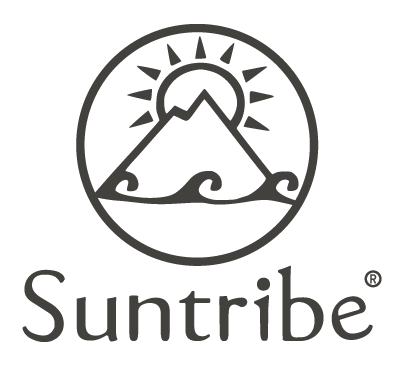The Suntribe FAQ
Woohoo! You’ve found our FAQ page. This must mean one of the following things: you’re confused about something we’ve said (or haven’t said), or you just really like visiting FAQ pages. Both are perfectly valid reasons, so let’s jump right in.

Delivery / Shipping / Availability
You can order from anywhere on planet earth!
Our warehouses are located in Germany and Sweden, which allows for fast world wide shipping. When placing an order before 12pm we are usually able to ship out your order the same afternoon and at the latest the day after. Here are the shipping times you can usually expect: Germany & Sweden: 2-4 working days. Europe: 2-9 working days. USA, Australia, Asia, South America: 4-14 working days. Africa: 8-14 working days.
We want you to be 120% happy, and therefore have a full refund policy within 30 days after you have received your order. It doesn’t matter if the product has been opened – please give it a full test at the beach or climb Mount Everest with it before you decide. If you’re unhappy with the products after having tested them, we will offer you a suitable solution, for example a free replacement or a money refund – simply write us to [email protected]. And if you actually manage to bring our sunscreen to the top of Everest, please send us pictures of your trip!
Easy! Write to [email protected] and we will help you to get started.
Yes, we ship worldwide!
According to the UK tax authorities you won’t pay any import taxes for shipments with a total value of less than 139 Pounds (which is usually the case with our shipments).
You can read up on it here: https://www.gov.uk/goods-sent-from-abroad and https://www.gov.uk/goods-sent-from-abroad/tax-and-duty
Following the second link you find this information: “You will not have to pay anything to the delivery company to receive goods worth less than £135 unless they’re gifts over £39 or excise goods (for example, alcohol and tobacco).”

Ingredients
No! Our sunscreens are 100% free from nanoparticles. We only use Non-Nano Zinc Oxide and Titanium Dioxide in our sunscreens.
May we ask back: why put in more ingredients than you actually need? We found that three to nine ingredients can guarantee the same degree of sun protection as 27, which is the number of ingredients an average sunscreen has.
The beauty of using less, and only the safest, ingredients lies in the fact that it reduces the potential negative side-effects for the environment and your health. While 63% of the ingredients used in the most popular sunscreens are classified as dangerous for man or nature, we stick to the ingredients most widely acclaimed for their safety for the environment and your health.
We use Non-Nano mineral UV-filters for two main reasons. Firstly, research shows that Non-Nano Zinc Oxide and Non-Nano Titanium Dioxide are the safest UV-filters in terms of safety for the environment, animals and humans.
To illustrate what we mean by safety, it is good to know the cautionary tale of Oxybenzone, the most commonly used chemical UV-filter, that has been shown to be responsible for threatening 10% of the world’s coral reefs with bleaching.
Secondly, Zinc Oxide and Titanium Dioxide are also very powerful UV-filters since they offer highly effective UVA and UVB protection. For us, mineral UV-filters really tick all the boxes.
In all our sunscreens we only use uncoated, non-irradiated and non-nano zinc oxide. These are the four reasons why we use uncoated Zinc Oxide:
1. Zinc Oxide in its uncoated form is less processed and comes closest to the mineral as it is mined in nature
2. Uncoated Zinc Oxide shows very little photoreactivity. In comparison to other UV-filters such as Zinc Oxide in nano form, Titanium Dioxide and chemical UV-filters, uncoated Non-Nano Zinc Oxide is more photostable and doesn’t break down as easily or release free radicals when exposed to UV-light.
3. Uncoated Zinc Oxide is safe to use according to the latest state of research. The Zinc Oxide in our sunscreens sits on the outer, dead layer of the skin (the stratum corneum) and free radicals, should they develop, do not reach the deeper, living cells of the skin. This study from the Australian government’s Department of Health and Ageing confirms this.
4. Our sunscreens contain inactive ingredients that scavenge and absorb free radicals, should they develop. For example, our sunscreen formulas contain Sunflower Seed Oil and Vitamin E for this purpose.
They are completely safe! The Iron Oxides we use in our products do not contain additives, they are a mineral and are approved for cosmetic and food products. They are considered safe for use on the skin and even for use in food.
Yes, all our sunscreens have passed the standard SPF, UVA and water resistance tests.

Sunscreens, Nature & Your Health
Many chemical ingredients used in conventional sunscreens have been found to be damaging to the environment. Oxybenzone, one of the most commonly used ingredients which is found in 3,500 brands of sunscreens worldwide, is of particular concern.
Researchers have found that Oxybenzone damages coral with on concentrations as low as 62 parts per trillion, which is equivalent to a single drop of water in six and a half Olympic-sized swimming pools. Considering the fact that between 6000-14000 tons of sunscreen end up in coral zones each year, one can easily imagine the devastating impact conventional sunscreens have on our planet’s precious coral reefs (Source).
We only use Non-Nano Zinc Oxide and Titanium Dioxide in our sunscreen. Titanium Dioxide and Zinc Oxide without nanoparticles are the only UVA & UVB blockers that have been deemed safe for coral reefs. Non-Nano Zinc Oxide and Titanium Dioxide are recommended by the Hawaiian Safe Sunscreen Council and EWG as the most environmentally friendly and skin-friendly available form of sunscreen protection.
We feel really ardent about two things: the great outdoors and the science behind our products. Here you can find the list of sources we ground the information on that you find on our website and further information material.
Environment Agency, 2008: UV-filters in cosmetics – prioritisation for environmental assessment.
Bohman, 2016. Miljöfarliga ingredienser i solskyddsprodukter.
Schlumpf, M., Cotton, B., Conscience, M., Haller, V., Steinmann, B. and Lichtensteiger, W., 2001. In vivo and in vitro estrogenicity of UV screens. Environmental Health Perspectives, 109, 239–44.
Seidlova-Wuttke, D., Christoffel, J., Rimoldi, G., Jarry, H. and Wuttke, W., 2005. Comparison of effects of estradiol with those of octylmethoxycinnamate and 4 methylbenzylidene camphor on fat tissue, lipids and pituitary hormones. Toxicology and Applied Pharmacology, 214, 1–7.
Hamann, I.H., Schmutzler, C., Kirschmeyer, P., Jarry, H. and Kohrle, J., 2006. 4- Methyl-benzylidene camphor (4MBC) causes pituitary effects comparable to hypothyroidism. Endocrine Abstracts, 11, OC60.
Danovaro, R., Bongiorni, R.L., Corinaldesi, C. et al., 2008. Sunscreens cause coral bleaching by promoting viral infections. Environmental Health Perspectives, 116, 441–447.
Coronado, M., Rempel, M.A. and Schlenk, D., 2006. Endocrine and reproductive effects of UV-filters, oxybenzone and benzophenone in fish. Abstract of an oral presentation given at the Dominican University of California, 14 April 2006.
As always, if you’d like to hear more, feel free to drop us a line at [email protected]
According to the latest state of research our sunscreens are safe to use for pregnant women. Suntribe’s formulas exclusively contain natural and organic oils, butters, waxes, minerals and vitamins that have all been proven safe for human health. They are safe for both the mother and the baby in the womb. We only use Non-Nano Zinc Oxide as the mineral UV-filter in our sunscreens, which is currently considered to be the safest choice for both human health and the environment. The fact that it is a mineral UV-filter means that it does not need to penetrate your skin in order to protect you. It forms an outer layer on your tissue like a protective shield and therefore safeguards you from the first moment of application. Since it is not absorbed into your skin, using our mineral sunscreen implies less risk for human health.

How to use
The Natural Mineral Face & Sport Zinc Sunscreen is a sunscreen formula reduced to the absolute minimum of ingredients for highest functionality. With all it’s benefits, there’s one important consideration with using in cold temperatures, as natural products have a tendency to harden. The product works and provides sun protection in all temperatures, but when it’s cold it needs some convincing. The product has its optimal consistency in temperatures above 21 degrees and when the air is colder you can apply the following tricks to make the sunscreen easier to apply:
- Keep the tin in a pocket close to your body or warm it in your hands before applying the sunscreen. Any place that is warmer than 21 degrees will make the sunscreen become softer and the metal of the tin will transport the heat to the sunscreen.
- Use your fingernails to get the sunscreen out of the tin, then warm the sunscreen in the palm of your hand. When the sunscreen gets in contact with your skin it will soften up very quickly.
- Apply when inside, before you go out, for example when skiing.
It depends on the product. To find out how long a specific product lasts go to the product listing at suntribesunscreen.com/shop and click the “Description” tab.
We produce our sunscreens freshly and in small batches to ensure you get the freshest products. Even when you notice that the best before date has passed, you can still use the product as long as it hasn’t changed noticeably in consistency or smell. Like with food, you can usually use the products a lot longer than indicated.
Make sure to store the products in a cool and dry place and they will stay fresh for a long time! If you are in doubt whether your product is still good to use, simply drop us a line and we’ll help you figure it out.
As a general rule we recommend to re-apply every two hours for full protection. However, this differs between the product in question and the scenario.
For example, if you go in and out of the water many times, or use a towel to wipe yourself, it’s best to re-apply more often.
On the other hand our most performance oriented product – the Suntribe Face & Sport Zinc Sunscreen – will protect you for a lot longer than two hours, even if you are in the water.
For full usage instructions go to suntribesunscreen.com/shop, select the product you want to know more about, and click the “How to Use” tab.
Great that you care about this question! We chose our materials on the premise that they can be recycled with ease and you find concrete “How to recycle” information for each product when clicking on the “Description” tab.
Our metal packagings (which we use for example for our Natural Mineral Face & Sport Zinc Sunscreens or our Natural Body Butter) go in the recycling bin for metal. Of course you can also repurpose this packaging quite easily, using the tins as airtight containers for solid natural shampoo for example (super convenient when travelling), or to transport surf wax, jewellery, money or other small stuff that you could otherwise lose easily. Simply remove the remaining sunscreen or body butter with a piece of kitchen paper before reusing it. This is only one example. For all other products, simply check the product description!
The recommended application amount for the face and neck combined is half a teaspoon.
For the body you should apply the equivalent of two tablespoons.
These quantities are equivalent to 2mg/cm2, which is actually the amount applied in the UVA & UVB tests in the laboratory.
Place small dots of sunscreen on the area of your body you’d like to protect. Then you can spread one dot after the other with circling movements, ensuring that all exposed skin is sufficiently covered and protected.
In addition to applying a sufficient amount of sunscreen, make sure to reapply at least every two hours, and right after drying yourself with a towel or going for a swim.


